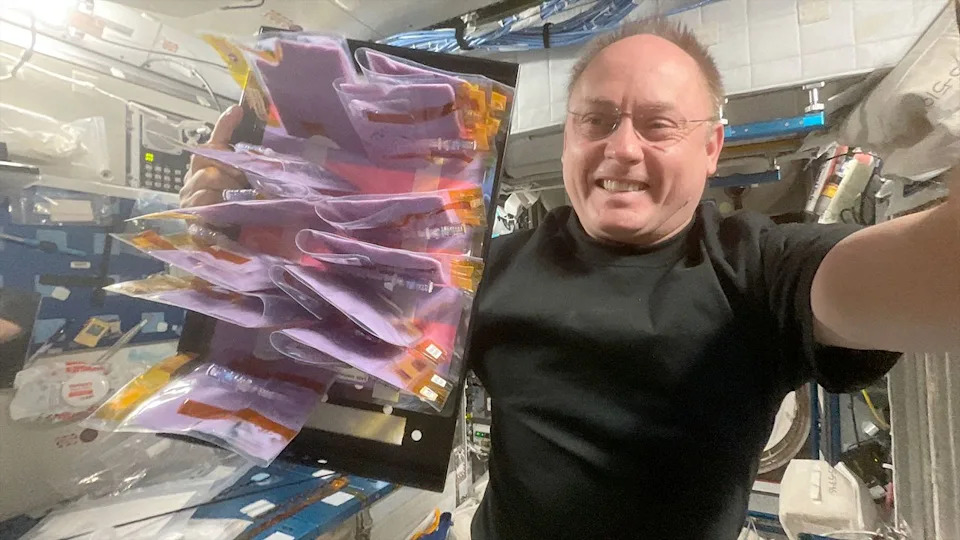Throughout human history, the quest for nourishment has been as much about survival as it has been about adaptation. Nowhere is this more evident than aboard the International Space Station (ISS), where from September 8 to 12, 2025, astronauts undertook an intriguing experiment: preparing and consuming purple kefir, a fermented dairy product rich in vitamins and probiotics. This seemingly simple act of cultivating a traditional Earth food in microgravity reveals layers of complexity in maintaining astronaut health, balancing nutrition, and even safeguarding mental well-being during long-duration space missions. As the boundaries of human presence extend further into the cosmos, the role of diet evolves from mere sustenance to a cornerstone of preventive medicine and psychological resilience.
Purple kefir, a vibrant variant of the classic fermented milk drink, is distinguished by the addition of natural pigments such as anthocyanins derived from purple corn or berries. These compounds are potent antioxidants, believed to play roles not only in combating oxidative stress but also in modulating inflammation and supporting the immune system—crucial factors in the uniquely challenging environment of space. Microgravity, cosmic radiation, and confinement collectively strain an astronaut’s physiology, often leading to muscle atrophy, bone density loss, and immune system dysregulation. Incorporating foods like purple kefir, rich in vitamins B complex, K2, and beneficial probiotics, represents a strategic approach to counteracting these effects. The fermentation process itself fosters beneficial microbial populations, which recent research suggests could help maintain gut health, a key component of overall wellness often disrupted during spaceflight (as detailed in this comprehensive NASA study on astronaut microbiomes).
The preparation of purple kefir aboard the ISS was more than a culinary novelty; it was an exercise in habit formation and self-care under conditions that test human adaptability. Astronauts, trained rigorously in scientific protocols, also benefit from rituals that anchor their daily routines amidst the disorienting environment of space. Fermenting kefir requires patience and attentiveness, fostering mindfulness and a tangible connection to Earthly rhythms. This aligns with emerging insights in space psychology, where maintaining mental health is as vital as physical fitness. The act of nurturing a living culture, watching it transform, and then consuming it for nourishment can provide a sense of accomplishment and normalcy, which are invaluable in the isolating vastness of orbit. The ISS crew’s initiative echoes a broader movement toward integrating holistic wellness practices in extreme environments, as explored in recent articles from the Journal of Space Psychology.
From a nutritional standpoint, the purple kefir experiment also serves as a testament to the ingenuity required to sustain long-term missions. Traditional space food has often been criticized for its lack of freshness and diversity, contributing to decreased appetite and nutrient deficiencies over time. Fermentation offers a promising avenue to enhance the palatability, shelf-life, and nutritional profile of onboard provisions. The probiotic content supports digestive health, potentially mitigating common gastrointestinal issues reported by astronauts. Moreover, the antioxidants in purple kefir could help neutralize free radicals induced by cosmic radiation exposure, a concern highlighted by numerous studies including those summarized in the European Space Agency’s nutrition guidelines.
This experiment also raises compelling questions about the future of food production beyond Earth’s orbit. As missions aim for lunar bases and eventually Mars, reliance on resupply missions will become impractical. Cultivating nutrient-dense, fermentable foods in situ will be essential for crew health and mission autonomy. The purple kefir trial aboard the ISS exemplifies early steps toward closed-loop life support systems, where biological cycles are harnessed to recycle resources and sustain human life. Such innovations resonate with broader ecological principles and could inform sustainable living practices back on Earth as well.

The blend of traditional fermentation with cutting-edge space technology also invites reflection on how cultural heritage intersects with scientific progress. Fermented foods like kefir have nourished humanity for millennia, their microbial communities a testament to the symbiosis between humans and nature. Bringing such practices into space underscores a profound continuity: even as we venture beyond our planet, we carry with us the wisdom embedded in everyday rituals. This convergence of old and new could shape the ethos of long-duration spaceflight, reminding us that health encompasses body, mind, and cultural identity.
As we reflect on this remarkable episode aboard the ISS, the preparation of purple kefir becomes emblematic of humanity’s enduring drive to adapt and thrive. It is a reminder that wellness is not a static goal but a dynamic process—one that requires creativity, resilience, and a profound respect for the interconnectedness of life. In the vastness of space, where the environment is alien and unforgiving, these lessons resonate deeply. Our journey beyond Earth will undoubtedly continue to challenge our understanding of health, but through experiments like this, we glimpse a future where nourishment is both a science and an art, sustaining explorers as they chart the final frontier.
Yet, the introduction of fermented foods like purple kefir into the space diet is more than a mere nutritional experiment; it touches upon the psychological and sensory dimensions of astronaut well-being. The monotony of space food, often limited to pre-packaged and rehydrated meals, can dull the senses and erode morale over time. By cultivating kefir onboard—a living culture that transforms simple ingredients into a tangy, effervescent beverage—astronauts engage in a tactile, almost meditative process that reconnects them with the rhythms of Earth. This act of creation, of nurturing a microbial ecosystem in microgravity, offers a subtle but powerful counterpoint to the sterile environment of the station. It’s a reminder that even in the most advanced technological settings, the human need for connection to natural processes remains vital.
Moreover, purple kefir’s deep violet hue, derived from antioxidant-rich berries, carries symbolic weight. Color, often overlooked in discussions of space nutrition, plays a crucial role in appetite and mood regulation. The vibrant tones of the beverage contrast sharply with the typically beige or pale foods common in space, potentially stimulating appetite and providing a psychological boost. This aligns with emerging research on the importance of sensory variety for long-term missions, where maintaining both physical health and emotional resilience is paramount. The incorporation of such visually striking, nutrient-dense foods could become a cornerstone in designing future space menus that nurture the whole person, not just their caloric needs.

The challenges of producing and sustaining probiotics in space also open new avenues for microbiome research. On Earth, the gut microbiota is influenced by a complex interplay of diet, environment, and lifestyle; in space, these factors shift dramatically. Studies have shown that microgravity can alter microbial populations, potentially impacting immune function and digestion. By experimenting with kefir cultures, scientists hope to better understand how beneficial bacteria survive, adapt, and function beyond our planet. This knowledge could lead not only to improved astronaut health but also to breakthroughs in managing microbiome-related conditions on Earth, especially in environments where access to fresh, fermented foods is limited.
Looking ahead, the successful cultivation of purple kefir might inspire the integration of other fermented products into space agriculture systems, creating closed-loop ecosystems that recycle resources and enhance food diversity. Such innovations are vital as humanity sets its sights on longer missions—to the Moon, Mars, and beyond—where resupply is infrequent and self-sufficiency is essential. The blending of traditional fermentation techniques with cutting-edge bioregenerative life support systems represents a melding of ancient wisdom and futuristic technology, a synthesis that could redefine how we sustain life in the cosmos.
Ultimately, the story of purple kefir aboard the ISS is a testament to human ingenuity and the enduring power of food as a source of comfort, culture, and health. It underscores a broader narrative: that in the quest to explore new worlds, we carry with us the intangible threads of our earthly heritage, weaving them into the fabric of spacefaring existence. As we continue to push the boundaries of exploration, such experiments remind us that nourishing the body is inseparable from nurturing the spirit—a lesson as vital on Earth as it is among the stars.
Yet, the challenges of producing and maintaining such delicate microbial communities in microgravity cannot be overstated. The absence of gravity alters fluid dynamics, microbial behavior, and even gene expression, factors that scientists aboard the ISS meticulously monitor. Early trials revealed that kefir grains—those gelatinous clusters of bacteria and yeast—behaved unpredictably, sometimes clumping or dispersing in ways unseen on Earth. These observations prompted a reevaluation of fermentation protocols, leading to the development of specialized containment vessels designed to harness the unique physics of space. This iterative process not only refined kefir production but also expanded our understanding of microbial adaptability, offering insights applicable to pharmaceuticals, waste recycling, and even the design of life-support systems for future habitats.

Moreover, the purple hue of this particular kefir variety, derived from anthocyanin-rich berries integrated into the fermentation process, adds another layer of intrigue. These natural pigments, known for their antioxidant properties, may confer additional protective benefits against the oxidative stress astronauts face in space. While the precise impact of such compounds in microgravity remains a subject of ongoing research, preliminary data suggest that the combination of probiotic bacteria and antioxidant-rich substrates could synergistically bolster immune function. This is especially pertinent given the documented alterations in astronaut immune responses during extended missions, where diminished defenses can increase vulnerability to latent viruses or opportunistic infections.
As the experiment progresses, the crew’s feedback on taste, texture, and overall satisfaction plays a crucial role. Food in space is far more than mere sustenance; it is a psychological anchor amid the sterile environment of the spacecraft. The introduction of fermented foods like purple kefir, with its tangy flavor and creamy consistency, offers a sensory reprieve, a reminder of Earth’s culinary diversity. Anecdotal reports from astronauts underscore how such foods evoke memories of home and foster camaraderie, reinforcing the notion that nourishment is as much about emotional well-being as it is about physical health.
Looking beyond the ISS, these findings could influence the design of nutrition systems for lunar bases or Martian colonies. The ability to cultivate probiotic-rich foods on-site reduces dependency on Earth-supplied supplements and introduces dynamic, living food sources into otherwise static menus. This aligns with NASA’s broader goals of sustainability and resilience, where every component of life support is optimized for efficiency and adaptability. Furthermore, the lessons learned from kefir fermentation may inspire the cultivation of other functional foods that address specific health challenges anticipated in extraterrestrial environments, such as bone density loss or muscle atrophy.
In essence, the purple kefir project exemplifies the intersection of microbiology, nutrition science, and space exploration, embodying a holistic approach to astronaut health. It is a vivid reminder that the quest for life beyond Earth is inseparable from the desire to preserve the richness of our terrestrial existence. As we continue to unravel the mysteries of how life thrives under the stars, each fermented grain, each cultured sip, becomes a symbol of resilience and innovation—a tiny but profound testament to humanity’s enduring spirit.
The meticulous preparation of purple kefir aboard the ISS is not merely a scientific experiment but also a delicate dance with the constraints of microgravity. Unlike on Earth, where fermentation is a process influenced by gravity’s pull, the orbital environment challenges these biological systems in unpredictable ways. Astronauts must carefully monitor temperature, humidity, and microbial activity within sealed bioreactors, often relying on remote guidance from terrestrial scientists. This intricate collaboration between spacefarers and ground control highlights a new paradigm in experimental biology—one where distance does not diminish the precision or enthusiasm for discovery. The visual transformation of the kefir grains, from translucent to a deep violet hue, is more than a biochemical curiosity; it serves as a tangible marker of success in adapting Earth’s microbiomes to alien conditions.

Yet, beyond the laboratory, these experiments resonate on a deeply human level. The astronauts’ journals reveal moments of quiet reflection as they sip the tangy, effervescent beverage, recalling family breakfasts or bustling markets where such fermented delights are commonplace. This sensory link to Earth offers psychological sustenance, a subtle balm against the isolation and monotony of spaceflight. Moreover, the antioxidant properties of the purple kefir—enhanced by the addition of anthocyanin-rich berries—may counteract oxidative stress, a known hazard of cosmic radiation exposure. This dual role of comfort and protection underscores the multifaceted value of fermented foods in space nutrition, challenging the traditional reliance on vitamin pills and freeze-dried meals.
Looking forward, the success of the purple kefir project opens intriguing possibilities for personalized nutrition in space. As omics technologies mature, astronauts might tailor their microbial companions to optimize gut health, immune function, and even mood regulation during long-duration missions. The concept of a “living pantry,” where fermentation processes yield fresh, nutrient-dense foods from minimal inputs, could redefine life support systems on Mars or beyond. Such innovations might also feedback to Earth, inspiring sustainable food production methods in resource-scarce environments or enhancing the nutritional profile of diets worldwide.
The journey of purple kefir from a humble fermented drink to a symbol of interplanetary resilience encapsulates the spirit of exploration itself—a fusion of tradition and innovation, science and story. It reminds us that as humanity reaches for the stars, it carries with it the tastes, textures, and microbial legacies of home. Each sip, each culture nurtured in orbit, is a quiet affirmation that even in the vast silence of space, life finds a way to flourish, adapt, and connect.
Yet, the challenges of sustaining such microbial ecosystems in microgravity are far from trivial. Early experiments aboard the ISS revealed that fermentation kinetics shift unpredictably without Earth’s gravitational cues, affecting both the texture and flavor profiles of cultured foods. For the purple kefir project, this meant scientists had to recalibrate fermentation times and temperatures meticulously, often relying on remote monitoring and astronaut feedback to fine-tune the process. These adjustments underscore a broader lesson in space biology: the complex interplay between microorganisms and their environment cannot be taken for granted, especially when gravity—the silent architect of so many biological processes—is absent.
The astronauts themselves become vital collaborators in this culinary science, their sensory perceptions and health markers guiding iterative improvements. One crew member, for instance, noted a surprisingly enhanced creaminess in the kefir after a slight extension of fermentation, a detail that sparked a deeper investigation into microbial strain behavior under orbital conditions. This participatory approach transforms space travelers into citizen scientists, bridging the gap between laboratory protocols and lived experience. It also humanizes the often sterile narrative of space nutrition, reminding us that food is not merely fuel but a source of comfort, morale, and cultural continuity.

Moreover, the psychological benefits of engaging with food preparation cannot be overstated. In the isolating expanse of the station, rituals like stirring a fermenting jar or sharing a freshly cultured snack foster a sense of normalcy and connection to Earthly rhythms. Researchers have long noted that such routines help mitigate the effects of confinement and monotony, which can be as taxing as the physical rigors of spaceflight. Purple kefir, with its vivid hue and tangy flavor, becomes a small but potent symbol of life’s persistence and adaptability, a tangible link between the crew and the ecosystems they momentarily leave behind.
Looking ahead, the integration of bioregenerative life support systems with fermentation technology promises a paradigm shift in how crews sustain themselves. Instead of shipping vast quantities of pre-packaged food, future missions might cultivate entire microbial communities that recycle waste, generate oxygen, and produce fresh nutrients concurrently. The purple kefir initiative is a stepping stone toward this vision, demonstrating the feasibility and benefits of onboard fermentation. As NASA and international partners plan for lunar bases and crewed Mars expeditions, such innovations will be indispensable in reducing resupply dependencies and enhancing crew autonomy.
Yet, these advances also raise intriguing ethical and safety questions. How do we ensure microbial strains do not evolve pathogenic traits in closed habitats? What protocols govern the introduction of genetically modified organisms in extraterrestrial environments? The stewardship of these tiny life forms demands vigilance and foresight, blending microbiology with planetary protection policies. In this way, the humble jar of purple kefir becomes a nexus of science, ethics, and exploration—a microcosm of humanity’s broader quest to inhabit new worlds responsibly.
As the ISS continues to orbit, carrying its precious microbial cargo, the story of purple kefir reminds us that space exploration is as much about nurturing life as it is about conquering the void. Each fermenting culture is a testament to human ingenuity and the enduring bond between Earth and sky, a flavorful thread weaving together past traditions and future frontiers.



